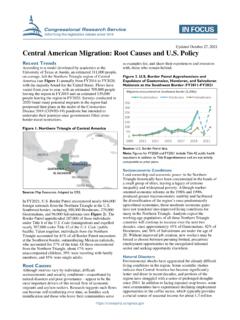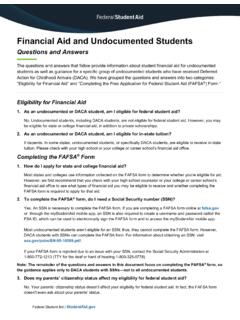Transcription of Federal Grants to State and Local Governments: A ...
1 Federal Grants to State and Local Governments: A Historical Perspective on Contemporary Issues Updated May 22, 2019 Congressional Research Service R40638 Federal Grants to State and Local Governments Congressional Research Service Summary The Federal government is expected to provide State and Local governments about $750 billion in Federal Grants in FY2019, funding a wide range of public policies, such as health care, transportation, income security, education, job training, social services, community development, and environmental protection. Federal Grants account for about one-third of total State government funding, and more than half of State government funding for health care and public assistance.
2 Congressional interest in Federal Grants to State and Local governments has always been high given the central role Congress has in determining the scope and nature of the Federal grant-in-aid system, the amount of funding involved, and disagreements over the appropriate role of the Federal government in domestic policy generally and in its relationship with State and Local governments. Federalism scholars agree that congressional decisions concerning the scope and nature of the Federal Grants -in-aid system are influenced by both internal and external factors. Internal factors include congressional party leadership and congressional procedures; the decentralized nature of the committee system; the backgrounds, personalities, and ideological preferences of individual Members; and the customs and traditions (norms) that govern congressional behavior.
3 Major external factors include input provided by voter constituencies, organized interest groups, the President, and executive branch officials. Although not directly involved in the legislative process, the Supreme Court, through its rulings on federalism issues, also influences congressional decisions concerning the Federal Grants -in-aid system. Overarching all of these factors is the evolving nature of cultural norms and expectations concerning government s role in American society. Over time, the American public has become increasingly accepting of government activism in domestic affairs generally, and of Federal government intervention in particular.
4 Federalism scholars attribute this increased acceptance of, and sometimes demand for, government action as a reaction to the industrialization and urbanization of American society; technological innovations in communications, which have raised awareness of societal problems; and exponential growth in economic interdependencies brought about by an increasingly global economy. This report provides a historical synopsis of the evolving nature of the Federal Grants -in-aid system, focusing on the role Congress has played in defining the system s scope and nature. It begins with an overview of the contemporary Federal Grants -in-aid system and then examines its evolution over time, focusing on the internal and external factors that have influenced congressional decisions concerning the system s development.
5 It concludes with an assessment of the scope and nature of the contemporary Federal Grants -in-aid system and raises several issues for congressional consideration, including possible ways to augment congressional capacity to provide effective oversight of this system. Federal Grants to State and Local Governments Congressional Research Service Contents The Congressional Role .. 1 Federal Grants to State and Local Governments .. 2 A Continuum of Federal Grant Administrative Conditions .. 3 Outlays for Federal Grants to State and Local Governments .. 4 Number of Federal Grants to State and Local Governments.
6 8 Land Grants and Dual Federalism : 1776-1860 .. 12 The Origins of the Modern Grants -In-Aid System: 1860-1932 .. 15 The New Deal and the Rise of Cooperative Federalism : 17 The Great Society and the Rise of Coercive Federalism : 1960-1980 .. 20 Another Related Development: Federal Mandates .. 26 Congress Asserts Its Authority: The Devolution Revolution That Wasn t, 1980-2000 .. 28 Federal Grants to State and Local Governments in the 21st 34 Congressional Issues .. 38 Concluding Remarks .. 39 Figures Figure 1. Outlays for Federal Grants to State and Local Governments, by Function, FY2019 Estimate.
7 6 Tables Table 1. Classification of Grant Types by Three Defining Traits .. 3 Table 2. Outlays for Federal Grants to State and Local Governments, by Function, Selected FY1902-FY2019 .. 5 Table 3. Outlays for Federal Grants to State and Local Governments, Percentage of Outlays for Individuals, in Constant Dollars, and as a Percentage of Total Federal Outlays and National Gross Domestic Product, Selected Fiscal Years, 1960-2019 .. 7 Table 4. Funded Federal Grants to State and Local Governments, by Type, Selected FY1902-FY2018 .. 10 Contacts Author Information.
8 40 Acknowledgments .. 40 Federal Grants to State and Local Governments Congressional Research Service 1 The Congressional Role Over the years, the Federal intergovernmental system of governance has been characterized by many scholars as becoming increasingly centralized and coercive, with the Federal government using Federal Grants , Federal mandates, and Federal preemption of State authority to expand its influence in many policy areas previously viewed as being the traditional responsibility of State and Local In FY2019, the Federal government is expected to provide State and Local governments about $750 billion in Federal Grants encompassing a wide range of public policy areas, such as health care, transportation, income security, education, job training, social services, community development, and environmental Federal Grants account for just under one-third of total State government funding, and more than half of State government funding for health care and public Congress has a central role in determining the scope and nature of Federal grant programs.
9 In its legislative capacity, Congress first determines what it wants to accomplish and then decides whether a grant-in-aid program is the best means to achieve it. Congress then selects which of the six grant mechanisms to use (project categorical grant, formula categorical grant, formula-project categorical grant, open-end reimbursement categorical grant, block grant, or general revenue sharing), and crafts legislation to accomplish its purpose, incorporating the chosen grant As with all legislation generally, Congress oversees the grant s implementation to ensure that the Federal administrating agency is held accountable for making certain that congressional expectations concerning program performance are met.
10 Federalism scholars agree that congressional decisions concerning the scope and nature of the Federal Grants -in-aid system are influenced by both internal and external factors. Internal factors include congressional party leadership and congressional procedures; the decentralized nature of the committee system; the backgrounds, personalities, and ideological preferences of individual Members (especially those of party leaders and committee and subcommittee chairs and ranking minority Members); and the customs and traditions (norms) that govern congressional behavior.














